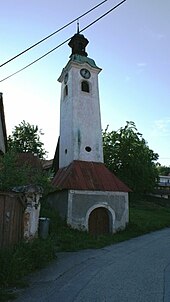Habaners

The term Habaner is a description for the Hutterites who immigrated to Slovakia from the middle of the 16th century . After the re-Catholicization of Slovakia in the 18th century, the term referred to those Catholicized Hutterites who still lived on the former Hutterite brother farms .
Surname
The name Habaner (Slovak: habáni ; Hungarian: habánerek and habánusok ; cf. French: les habans ) probably goes back to the Hebrew ha-banim (for example: the children of [God] ). The representatives of the Anabaptist movement did not refer to themselves as Anabaptists or even Anabaptists in the first years of their existence . They adhered to biblical guidelines in their self-designations. In this context, the term children of God was very common, as it was also used on the front page of the Schleitheim article ( Brotherly Association of Several Children of God, relating to seven articles ). In the Slovak environment, ha-banim became the popular name habáni , which was then translated into German as Habaner .
Another explanation of the term is based on the term household for the Hutterite brother farms .
history

The Hutterites still represent a denomination of the radical Reformation Anabaptist movement . In the 16th and 17th centuries, the Anabaptists named after Jakob Hutter settled on their flight from persecution from Germany and Switzerland, mainly in southern Moravia and western Slovakia . In 1539 they were expelled from Lower Austria, with communities such as Eggenburg , Drasenhofen or Steinebrunn being dissolved. Especially after the beginning of the Counter Reformation in Moravia in 1622, several thousand Hutterites finally moved to Slovakia, which at that time still belonged to Hungary . Here they lived and worked in mostly closed communitarian communities (called Bruderhöfe or "Haushaben"). With their craft skills and knowledge of viticulture and pharmacy , they had a great influence on their environment. The pottery Haban faience produced by the Hutterites also found great sales. For the Hutterites settling in Slovakia, the term Habaner soon became common in the surrounding Slovakian environment. Even after the re-Catholicization of Slovakia by force in the middle of the 18th century, the term remained for the formerly Hutterite and now Catholic residents of the Bruderhöfe. In part, the cooperative structures of the Bruderhöfe continued to exist. At the beginning of the 20th century there were a few German-speaking Habans in western Slovakia. Nevertheless, the Habans were largely Slavic by the mid-20th century. The term still lives on today in the form of the Haban faience that was once produced by the Hutterites. Even among the Hutterites who emigrated to North America, many refer to the Habanic tradition from Slovakia.
literature
- M. Pfister: About the Habaners and their settlement areas in the ČSSR . In: Habaner Fayencen 1590-1730 = ceramics from Czechoslovakia . Cantonal office for economic and cultural exhibitions in the Kornhaus Bern et al., Bern 1986, pp. 4–6.
- Theodor Brückler: Anabaptists - Hutterites - Habans. History, settlements, ceramics in South Moravia, West Slovakia and Bohemia . Contributors Alena Kalinová, Brigitte Fassbinder-Brückler u. a. Berger, Horn 2004 ISBN 3-901693-01-10 , series: Research from the Stadtmuseum Alte Hofmühle Hollabrunn, special volume, exhibition catalog
- Imre Katona: A habán kerámia Magyarországon. Képzömüvészeti Alap Kiadóvállalata, Budapest 1976
Web links
- Robert Friedmann: Habáner . In: Global Anabaptist Mennonite Encyclopedia Online
- The Habaners in Slovakia in Carpathian Journal , November 1, 2000
- Maria H. Krisztinkovich , Vancouver : Anabaptists and Arians in the Carpathian region. 1971. With num. Bibliography
Individual evidence
- ↑ Entry on Habaners in the Landes database for the history of Lower Austria ( Museum Niederösterreich ), accessed on November 3, 2012
